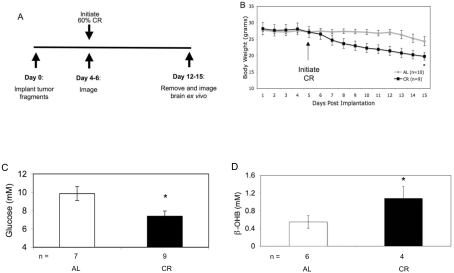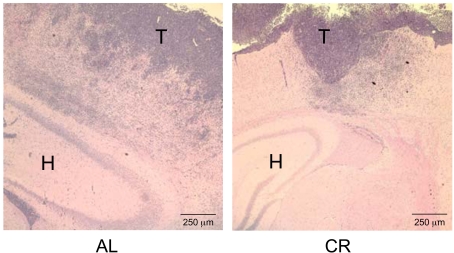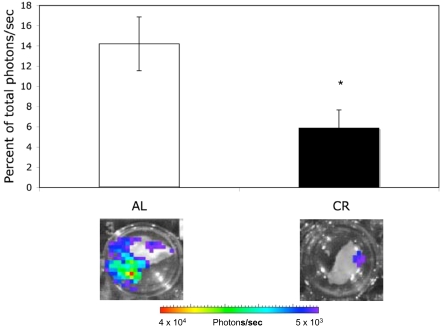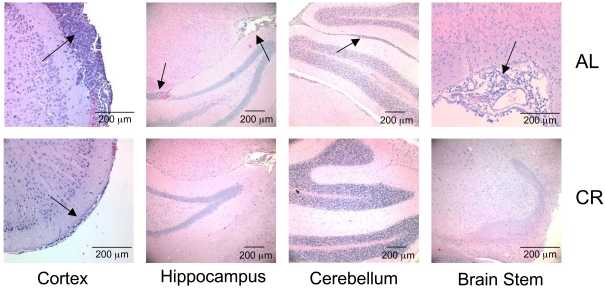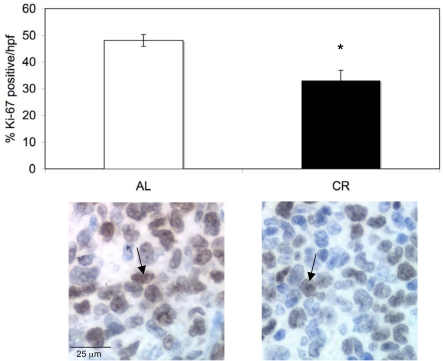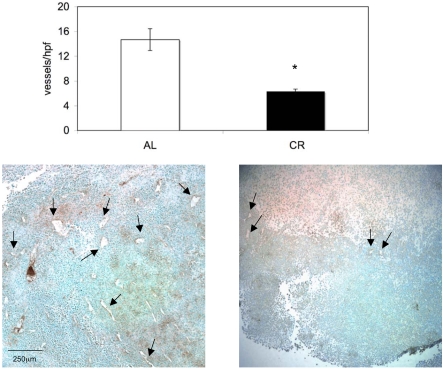Abstract
GBM (glioblastoma multiforme) is the most aggressive and invasive form of primary human brain cancer. We recently developed a novel brain cancer model in the inbred VM mouse strain that shares several characteristics with human GBM. Using bioluminescence imaging, we tested the efficacy of CR (calorie restriction) for its ability to reduce tumour size and invasion. CR targets glycolysis and rapid tumour cell growth in part by lowering circulating glucose levels. The VM-M3 tumour cells were implanted intracerebrally in the syngeneic VM mouse host. Approx. 12–15 days post-implantation, brains were removed and both ipsilateral and contralateral hemispheres were imaged to measure bioluminescence of invading tumour cells. CR significantly reduced the invasion of tumour cells from the implanted ipsilateral hemisphere into the contralateral hemisphere. The total percentage of Ki-67-stained cells within the primary tumour and the total number of blood vessels was also significantly lower in the CR-treated mice than in the mice fed ad libitum, suggesting that CR is anti-proliferative and anti-angiogenic. Our findings indicate that the VM-M3 GBM model is a valuable tool for studying brain tumour cell invasion and for evaluating potential therapeutic approaches for managing invasive brain cancer. In addition, we show that CR can be effective in reducing malignant brain tumour growth and invasion.
Keywords: calorie restriction, glioblastoma multiforme, Ki-67, VM mouse
Abbreviations: AL, ad libitum; CR, calorie restriction; GBM, glioblastoma multiforme; H & E, haematoxylin and eosin; i.c., intracerebrally; IGF-1, insulin-like growth factor 1; VM-M3, mouse malignant glioma; VM-M3/Fluc, VM-M3 cells labelled with firefly luciferase
INTRODUCTION
Otto Warburg originally proposed that many cancers were heavily dependent on glycolysis, even in the presence of oxygen, suggesting an impairment in mitochondrial respiration (Warburg, 1956). This aerobic glycolysis resulted in the dependence of tumour cells on glucose for energy and survival. Therefore exploiting abnormal brain tumour metabolism has become an attractive approach for cancer management in both human patients and in animal models (Seyfried et al., 2003; Seyfried and Mukherjee, 2005; Zuccoli et al., 2010). We previously showed that restricted caloric intake significantly reduces the size and angiogenesis of mostly non-invasive experimental mouse and human brain tumours (Mukherjee et al., 2002, 2004; Zhou et al., 2007). CR (calorie restriction) lowers circulating blood glucose levels, thereby reducing carbohydrate energy for the tumour cells (Seyfried et al., 2003; Seyfried and Mukherjee, 2005). In addition, CR reduces free radical production and thus inflammation (Veech, 2004; Seyfried and Mukherjee, 2005; Longo and Fontana, 2010). Normal brain cells transition to ketone bodies for energy, which become elevated under CR (Seyfried and Mukherjee, 2005). Evidence in humans has confirmed previous studies in mice that high blood glucose levels predict poor prognosis for GBM (glioblastoma multiforme), the most malignant and invasive form of adult primary brain cancer (Seyfried et al., 2003; McGirt et al., 2008; Derr et al., 2009). Although therapeutic fasting and a restricted ketogenic diet was effective in managing GBM in an older patient (Zuccoli et al., 2010), no prior studies have evaluated the therapeutic effect of CR on invasive brain cancer in mice.
We recently described the VM-M3 murine brain tumour cell line, which is highly invasive when implanted orthotopically in the brain (Huysentruyt et al., 2008; Shelton et al., 2010). The VM-M3 GBM model is the only known mouse brain tumour expressing the ‘secondary structures of Scherer’ including diffuse parenchymal invasion, perivascular growth, subpial surface growth and growth along white matter tracts (Shelton et al., 2010). In the present study, we evaluated the effect of CR on the proliferation and invasion of the VM-M3 tumour when grown orthotopically in its immunocompetent syngeneic host. We found that CR significantly inhibited VM-M3 growth and distal brain invasion.
MATERIALS AND METHODS
Mice
Mice of the VM/Dk (VM) strain were obtained as a gift from Dr H. Fraser (University of Edinburgh, Edinburgh, Scotland, U.K.). All mice used in the present study were housed and bred in the Boston College Animal Care Facility using husbandry conditions as described previously (Ranes et al., 2001). All mice received Prolab RMH 3000 chow (LabDiet). The diet contains a balance of mouse nutritional ingredients and delivers 4.4 kcal/g gross energy, where fat, carbohydrate, protein and fibre comprised 55, 520, 225 and 45 g/kg of the diet respectively. All animal procedures were in strict accordance with the NIH (National Institutes of Health) Guide for the Care and Use of Laboratory Animals and were approved by the Institutional Animal Care Committee.
Tumour formation
The VM-M3 tumour arose spontaneously in the cerebrum of an adult male VM mouse as described previously (Huysentruyt et al., 2008). The tumours were grossly identified in the cerebrum similar to those described previously for other spontaneous tumours in the VM mouse brain (Fraser, 1986; El-Abbadi et al., 2001). In order to preserve in vivo viability, the tumour was immediately resected and implanted i.c. (intracerebrally) into host VM mice as described below. As soon as cranial domes appeared, the tumours were passaged again into several host VM mice. After a total of three i.c. passages, the tumours were grown s.c. (subcutaneously) and cell lines were prepared from the tumour as described previously (Huysentruyt et al., 2008).
Transduction of cell lines
The VM-M3 cell line was transduced with a lentivirus vector containing the firefly luciferase gene under control of the cytomegalovirus promoter (VM-M3/Fluc) described previously (a gift from Dr Miguel Sena-Esteves, Neuroscience Center at Massachusetts General Hospital, Charleston, MA, U.S.A.) (Huysentruyt et al., 2008).
Tumour implantation
Tumour implantation was performed as described previously (Ranes et al., 2001). Briefly mice were anaesthetized with Avertin (0.1ml/10 g of body weight). The tops of the heads were disinfected with ethanol and a small incision was made in the scalp of the mouse over the midline. A 3 mm3 burr hole was made in the skull over the right cerebral hemisphere. Using a trocar, a small tumour fragment (1 mm3) was implanted into the hole made in the skull. The flaps of skin were then immediately closed with collodion adhesive. The mice were placed in a warm room (37°C) until they fully recovered.
Imaging
The Xenogen IVIS system was used to record the bioluminescent signal from the labelled tumours as we described recently (Huysentruyt, et al. 2008; Shelton et al., 2010). Briefly, mice received an intraperitoneal injection of d-luciferin (50 mg/kg of body weight; Promega) in PBS and Avertin (0.1 ml/10 g of body weight) prior to imaging. Imaging times ranged from 3 to 10 min, depending on the time point. Longer imaging times were used initially to assess tumour ‘take’, i.e. that tumours were actually growing in the mice. For ex vivo imaging, brains were removed and sectioned through the midline. Individual hemispheres were imaged separately in 300 μg/ml d-luciferin in PBS, and imaged from 3 to 10 min. Identical imaging times were used for both AL (ad libitum) and CR groups for each hemisphere. However, the contralateral hemisphere was imaged for a longer period than the ipsilateral hemisphere to ensure detection of the invasive tumour cells. The IVIS Lumina cooled CCD (charge-coupled-device) camera system was used for light acquisition. Data acquisition and analysis was performed with Living Image® software (Caliper LS).
Dietary regimens, body weight and food intake measurements
Adult male and female VM mice (approx. 60–90 days old) were individually housed 1–2 days prior to tumour cell implantation. Mice were kept in filter-topped plastic cages containing Sani-Chip bedding (P.J. Murphy Forest Products Corporation). Body weight and food intake was recorded daily and standard chow was provided AL. Tumour fragments were implanted on day zero (Figure 1A). The mice were then matched for body weight and separated into two groups (AL and CR) 4–6 days post-implantation. Imaging confirmed the presence of a growing tumour in each implanted mouse. Mice were administered the standard chow diet either AL or restricted to 40% of their normal food intake (60% restriction) at approx. the same time (10:00 hours) each day. All mice were weighed daily prior to food administration. Mice were sacrificed at the time of morbidity, which was approx. 12–15 day post-implantation for the control AL mice (Figure 1A).
Figure 1. Study design and influence of CR on body weights and plasma glucose levels.
(A) VM mice were implanted with VM-M3/Fluc tumour fragments as described in the Material and methods section and were given a 60% CR starting on days 4–6. Brains were removed 12–15 days post-implantation and imaged ex vivo. (B) The body weights of the VM mice were monitored daily. Values represent the means±S.E.M. for 9–10 mice per group. VM mice were sacrificed and plasma was collected for the analysis of glucose (C) and ketones (D) as described in the Materials and methods section. Values represent the means±S.E.M. The * indicates that the CR values differ significantly from those of the AL control group at P<0.05 using the two-tailed Student's t test.
Plasma glucose measurements
Mice were anaesthetized with isoflurane (Halocarbon Laboratories) and euthanized by exsanguination, involving collection of blood from the heart in heparinized tubes. (Marsh et al., 2008b). Both the AL and the CR groups were fasted 3–4 h before being sacrificed. The blood plasma was collected and centrifuged at 4000 g for 20 min and was stored at −80°C until analysis. Plasma glucose concentration was measured in a spectrophotometer using the Stanbio Enzymatic Glucose Procedure.
Ketone determination
The ketone body β-OHB (β-hydroxybutyrate) was measured enzymatically in plasma or serum with a modification of the procedure described by Williamson et al. (1962).
Histology
Brain tumour samples were fixed in 10% neutral-buffered formalin (Sigma) and embedded in paraffin. The brain tumour samples were sectioned at 5 μm, were stained with H & E (haematoxylin and eosin) at the Harvard University Rodent Histopathology Core Facility (Boston, MA, U.S.A.) and were examined by light microscopy using either a Zeiss Axioplan 2 or Nikon SMZ1500 light microscope as we described previously (Mukherjee et al., 2002). Images were acquired using SPOT Imaging Solutions (Diagnostic Instruments) cameras and software. All histological sections were evaluated by a veterinary neuropathologist (Roderick Bronson) at the Harvard University Rodent Histopathology Core Facility.
Immunohistochemical staining
The brain tissue sections were deparaffinized, rehydrated and washed as described previously (Mukherjee et al., 2004). Sections that were stained with Factor VIII were incubated with trypsin at 37°C for 30 min following deparaffinization and rehydration. The tissue sections were then heat-treated (95°C) in antigen unmasking solution (Vector Laboratories) for 30 min. Tissue sections were blocked in goat serum (1:10 in PBS) for 1 h at room temperature (22–25°C) and treated with either Ki-67 primary antibody (rat monoclonal used at 1:100; Dako), or Factor VIII primary antibody (rabbit polycolonal used at 1:100; Dako), overnight at 4°C, followed by a biotinylated anti-rat or anti-rabbit secondary antibody at a 1:100 dilution (Vector Laboratories). The sections were then treated with avidin–biotin complex followed by 3,3′-diaminobenzidine as the substrate for staining according to the manufacturer's protocol (Vectastain Elite ABC kit; Vector Laboratories). The sections were counterstained with haematoxylin (Ki-67) or Methyl Green (Factor VIII) and mounted. Corresponding tissue sections without primary antibody served as negative controls. A Zeiss Axioplan 2 light microscope was used to capture bright-field images as described above. The percentage of Ki-67-positive cells were determined using a Photoshop-based image analysis as described previously (Lehr et al., 1999). MVD (microvessel density) was quantified by examining areas of vascular hot spots as described previously by Weidner et al. (1991), with some modifications (Mukherjee et al., 2004). Sections were scanned at low magnification (×40 and ×100) for the localization of vascular hot spots. The three most vascular areas of the tumour not containing necrosis were determined and then counted at higher magnification (×200). The values of the three sections were averaged for all tumours.
RESULTS
No prior studies have evaluated the influence of CR against invasive brain cancer in mice. The objective of the present study was to determine whether CR could be effective for managing contralateral hemispheric invasion of VM-M3 tumour cells.
Effect of calorie restriction on body weights, and plasma glucose and ketones
We first evaluated the effect of a 60% dietary restriction on body weights and plasma glucose (Figure 1). CR significantly reduced the body weights of the mice by the end of the study (Figure 1B). In addition, circulating glucose levels were significantly lower in the CR group than in the control AL fed group (Figure 1C). Circulating ketone levels were significantly higher in the CR group than in the AL group (Figure 1D).
Effect of calorie restriction on tumour growth and invasion
As seen in Figure 2, CR reduced the growth and invasion of the VM-M3 primary tumour. Compared with the diffuse, ill-defined border of the VM-M3 tumour observed in the AL-fed control mice, the tumour grown in the CR mice appeared denser with a more defined border. We evaluated the level of invasion into the contralateral hemisphere using bioluminescent imaging as described in the Materials and methods section. The total amount of bioluminescence in the contralateral hemisphere was significantly less in the CR-fed mice than in the AL-fed mice (Figure 3). Histology was used to confirm the extent of tumour-cell invasion into the contralateral hemisphere between the AL and CR groups. As shown in Figure 4, invading tumour cells were identified in all regions of the contralateral hemisphere of the AL-fed mice (arrows). In contrast, we identified sub-pial spread only to the cortex in the contralateral hemisphere of the CR group. The number of migrating cells was also noticeably less in the CR-fed mice than in the AL-fed mice (Figure 4). In addition, the percentage of Ki-67-positive tumour cells was significantly lower in the CR mice than in the AL mice (Figure 5). Factor VIII staining was used to measure blood vessel density in the tumours (Figure 6). Blood vessel density was significantly lower in the primary tumours of CR mice than in the AL mice. Blood vessel size was also smaller in the tumours of the CR mice than the AL mice (Figure 6).
Figure 2. Influence of CR on VM-M3/Fluc tumour growth.
VM-M3/Fluc tumour fragments were implanted as described in Figure 1. Post-imaging, brains were fixed and stained with H & E as described in the Materials and methods section. Images are shown at 50× (T, tumour; H, hippocampus). At least three samples were examined per group.
Figure 3. Influence of CR on bioluminescence in the contralateral hemisphere.
VM-M3/Fluc tumour fragments were implanted as described in Figure 1. Each hemisphere was imaged for bioluminescence ex vivo as described in the Materials and methods section. The bioluminescence from each hemisphere was added together to obtain a total bioluminescence value (photons/s) for each brain. Data for the contralateral hemisphere was then expressed as the percentage of the total brain photons/s. Values represent the means±S.E.M. for 9–10 mice per group. Representative bioluminescence images are shown. The * indicates that the CR values differ significantly from the AL control group at P<0.05 using the two-tailed Student's t test.
Figure 4. Influence of CR on VM-M3/Fluc tumour cell invasion to the contralateral hemisphere.
VM-M3/Fluc tumour fragments were implanted as described in Figure 1. Histological analysis (H&E) was used to validate the presence of tumour cells under AL (top panels) and CR (bottom panels) in cerebral cortex (200×), hippocampus (100×), cerebellum (100×) and brain stem (200×). Arrows indicate the presence of tumour cells. At least three samples were examined per group.
Figure 5. Influence of CR on Ki-67 staining in the primary tumour.
The qualitative and quantitative analysis of Ki-67-positive tumour cells in tissue sections was evaluated as described in the Materials and methods section. Ki-67-positive tumour cells were counted in three independent areas under high magnification and averaged for a single value per sample. Values represent the means±S.E.M. for three independent samples per group. The * indicates that the values for the CR group differ from those of the AL control group at a P<0.05 using the two-tailed Student's t test. Representative immunohistological sections are shown. Images are shown at 400×. Ki-67-positive cells are indicated in brown and by the arrow.)
Figure 6. Influence of CR on blood vessels in the primary tumour.
Blood vessels were stained with the Factor VIII antibody as described in the Materials and methods section. Blood vessels were counted in three independent areas under high magnification and averaged for a single value per sample. Values represent the means±S.E.M. for three independent samples per group. The * indicates that the values for the CR group differ from those of the AL control group at a P<0.05 using the two-tailed Student's t test. Representative immunohistological sections are shown. Images are shown at 100×. Arrows identify blood vessels.
DISCUSSION
We found that CR, which significantly reduces tumour growth and angiogenesis in the non-invasive murine and human experimental models (Mukherjee et al., 2002, 2004; Zhou et al., 2007), also reduced tumour growth and invasion in the newly established VM-M3 model of human GBM (Shelton et al., 2010). Previous studies in mice showed that high blood glucose levels were predictive of rapid glioma growth and angiogenesis (Mukherjee et al., 2002; Seyfried et al., 2003; Marsh et al., 2008a). Recent studies in humans have also linked high circulating glucose levels with poor prognosis in patients with GBM (McGirt et al., 2008; Derr et al., 2009). Additionally, a restricted ketogenic diet has been introduced into the clinical setting with positive results in both children and in an older adult (Nebeling et al., 1995; Zuccoli et al., 2010). Because most brain tumours are highly glycolytic, they rely heavily on glucose as a major energy source (Warburg, 1956; Seyfried and Mukherjee, 2005). CR lowers circulating glucose and targets those pathways associated with tumour glycolysis (Seyfried et al., 2003; Seyfried and Mukherjee, 2005; Marsh et al., 2008; Seyfried and Shelton, 2010). In addition to reducing glucose, CR also elevates circulating ketone bodies that are metabolized for energy by normal brain cells when glucose levels are reduced (Seyfried and Mukherjee, 2005; Zhou et al., 2007). Ketone body metabolism takes place in the mitochondria and provides non-glucose-derived reducing equivalents for oxidative phosphorylation. The VM-M3 cell line, however, has alterations in both mitochondrial lipid composition and electron transport chain enzyme activities, which would compromise normal mitochondrial function (Kiebish et al., 2008). In addition, the VM-M3 cell line was unable to transition to ketones under low-glucose conditions in vitro, whereas normal astrocytes successfully grew under low-glucose, high-ketone conditions (L.M. Shelton and T.N. Seyfried, unpublished data). These findings indicate that brain tumour cells are more sensitive to energy stress than normal brain cells and can be targeted through principles of metabolic control theory (Seyfried and Mukherjee, 2005; Seyfried et al., 2008).
We and others previously showed that dietary energy restriction could reduce IGF-1 (insulin-like growth factor 1)/PI3K (phosphoinositide 3-kinase)/Akt/HIF-1α (hypoxia-inducible factor 1α) signalling, which drives tumour cell growth and metabolism (Marsh et al., 2008; Moore et al., 2008). Previous studies also showed that CR lowers circulating levels of IGF-1 and VEGF (vascular endothelial growth factor), which stimulate angiogenesis (Kari et al., 1999; Seyfried et al., 2003; Zhu et al., 2003; Mukherjee et al., 2004). In the present study we showed that CR also significantly reduced the percentage of Ki-67-positive tumour cells, an indicator of cell proliferation (Li et al., 2009). High Ki-67 expression is a negative prognostic factor for patients with GBM (Persson and Englund, 2008; Li et al., 2009). We also found that VM-M3 blood vessel density and size was significantly lower in CR-treated mice than in mice fed AL. Viewed collectively, these findings indicate that the anti-invasive properties of CR can be due, in part, to a reduction of proliferative, glycolytic and angiogenic factors.
CR significantly reduced tumour invasion into the contralateral hemisphere, but did not completely inhibit all invasion. We previously showed that a restricted ketogenic diet used in combination with 2DG (2-deoxy-d-glucose), a potent glycolysis inhibitor, achieved synergy with regard to reductions in tumour size (Marsh et al., 2008). The mechanisms by which CR reduces VM-M3 cell invasion is not yet clear, but could involve a reduction in angiogenesis, which correlates with invasion and is significantly reduced under CR as we previously showed (Mukherjee et al., 2002, 2004; Lakka and Rao, 2008). The anti-inflammatory properties of ketone body metabolism might also, in part, reduce tumour cell invasion. We suggest that CR or restricted ketogenic diets can be used in conjunction with low-dose chemotherapeutic agents to enhance efficacy while reducing drug toxicity. Recent studies in humans also showed that fasting could enhance the therapeutic efficacy of chemotherapy (Safdie et al., 2009). In conclusion, in the present study we found that CR significantly reduced invasion and proliferation of the VM-M3 model of invasive brain cancer, suggesting that diets which lower glucose and elevate ketone levels can be therapeutic for invasive brain tumours.
ACKNOWLEDGEMENTS
We thank Roderick Bronson for technical advice and evaluation of tumour histology.
Footnotes
This work was supported by the National Institutes of Health [grant numbers NS-055195, CA-102135]; and by the Boston College Research Expense Fund.
REFERENCES
- Derr RL, Ye X, Islas MU, Desideri S, Saudek CD, Grossman SA. Association between hyperglycemia and survival in patients with newly diagnosed glioblastoma. J Clin Oncol. 2009;27:1082–1086. doi: 10.1200/JCO.2008.19.1098. [DOI] [PMC free article] [PubMed] [Google Scholar]
- El-Abbadi M, Seyfried TN, Yates AJ, Orosz C, Lee MC. Ganglioside composition and histology of a spontaneous metastatic brain tumour in the VM mouse. Br J Cancer. 2001;85:285–292. doi: 10.1054/bjoc.2001.1909. [DOI] [PMC free article] [PubMed] [Google Scholar]
- Fraser H. Brain tumours in mice, with particular reference to astrocytoma. Food Chem Toxicol. 1986;24:105–111. doi: 10.1016/0278-6915(86)90344-3. [DOI] [PubMed] [Google Scholar]
- Huysentruyt LC, Mukherjee P, Banerjee D, Shelton LM, Seyfried TN. Metastatic cancer cells with macrophage properties: evidence from a new murine tumor model. Int J Cancer. 2008;123:73–84. doi: 10.1002/ijc.23492. [DOI] [PubMed] [Google Scholar]
- Kari FW, Dunn SE, French JE, Barrett JC. Roles for insulin-like growth factor-1 in mediating the anti-carcinogenic effects of caloric restriction. J Nutr Health Aging. 1999;3:92–101. [PubMed] [Google Scholar]
- Kiebish MA, Han X, Cheng H, Chuang JH, Seyfried TN. Cardiolipin and electron transport chain abnormalities in mouse brain tumor mitochondria: lipidomic evidence supporting the Warburg theory of cancer. J Lipid Res. 2008;49:2545–2556. doi: 10.1194/jlr.M800319-JLR200. [DOI] [PMC free article] [PubMed] [Google Scholar]
- Lakka SS, Rao JS. Antiangiogenic therapy in brain tumors. Exp Rev Neurother. 2008;8:1457–1473. doi: 10.1586/14737175.8.10.1457. [DOI] [PMC free article] [PubMed] [Google Scholar]
- Lehr HA, van der Loos CM, Teeling P, Gown AM. Complete chromogen separation and analysis in double immunohistochemical stains using Photoshop-based image analysis. J Histochem Cytochem. 1999;47:119–126. doi: 10.1177/002215549904700113. [DOI] [PubMed] [Google Scholar]
- Li SW, Qiu XG, Chen BS, Zhang W, Ren H, Wang ZC, Jiang T. Prognostic factors influencing clinical outcomes of glioblastoma multiforme. Chin Med J. 2009;122:1245–1249. [PubMed] [Google Scholar]
- Longo VD, Fontana L. Calorie restriction and cancer prevention: metabolic and molecular mechanisms. Trends Pharmacol Sci. 2010;31:89–98. doi: 10.1016/j.tips.2009.11.004. [DOI] [PMC free article] [PubMed] [Google Scholar]
- Marsh J, Mukherjee P, Seyfried TN. Akt-dependent proapoptotic effects of caloric restriction on late-stage management of a PTEN/TSC2-deficient mouse astrocytoma. Proc Am Assoc Cancer Res. 2008;14:7751–7762. doi: 10.1158/1078-0432.CCR-08-0213. [DOI] [PubMed] [Google Scholar]
- Marsh J, Mukherjee P, Seyfried TN. Drug/diet synergy for managing malignant astrocytoma in mice: 2-deoxy-d-glucose and the restricted ketogenic diet. Nutr Metab (London) 2008b;5:33–37. doi: 10.1186/1743-7075-5-33. [DOI] [PMC free article] [PubMed] [Google Scholar]
- McGirt MJ, Chaichana KL, Gathinji M, Attenello F, Than K, Ruiz AJ, Olivi A, Quinones-Hinojosa A. Persistent outpatient hyperglycemia is independently associated with decreased survival after primary resection of malignant brain astrocytomas. Neurosurgery. 2008;63:286–291. doi: 10.1227/01.NEU.0000315282.61035.48. [DOI] [PubMed] [Google Scholar]
- Moore T, Beltran L, Carbajal S, Strom S, Traag J, Hursting SD, DiGiovanni J. Dietary energy balance modulates signaling through the Akt/mammalian target of rapamycin pathways in multiple epithelial tissues. Cancer Prev Res. 2008;1:65–76. doi: 10.1158/1940-6207.CAPR-08-0022. [DOI] [PubMed] [Google Scholar]
- Mukherjee P, El-Abbadi MM, Kasperzyk JL, Ranes MK, Seyfried TN. Dietary restriction reduces angiogenesis and growth in an orthotopic mouse brain tumour model. Br J Cancer. 2002;86:1615–1621. doi: 10.1038/sj.bjc.6600298. [DOI] [PMC free article] [PubMed] [Google Scholar]
- Mukherjee P, Abate LE, Seyfried TN. Antiangiogenic and proapoptotic effects of dietary restriction on experimental mouse and human brain tumors. Clin Cancer Res. 2004;10:5622–5629. doi: 10.1158/1078-0432.CCR-04-0308. [DOI] [PubMed] [Google Scholar]
- Nebeling LC, Miraldi F, Shurin SB, Lerner E. Effects of a ketogenic diet on tumor metabolism and nutritional status in pediatric oncology patients: two case reports. J Am Coll Nutr. 1995;14:202–208. doi: 10.1080/07315724.1995.10718495. [DOI] [PubMed] [Google Scholar]
- Persson A, Englund E. Different assessments of immunohistochemically stained Ki-67 and hTERT in glioblastoma multiforme yield variable results: a study with reference to survival prognosis. Clin Neuropathol. 2008;27:224–233. doi: 10.5414/npp27224. [DOI] [PubMed] [Google Scholar]
- Ranes MK, El-Abbadi M, Manfredi MG, Mukherjee P, Platt FM, Seyfried TN. N-butyldeoxynojirimycin reduces growth and ganglioside content of experimental mouse brain tumours. Br J Cancer. 2001;84:1107–1114. doi: 10.1054/bjoc.2000.1713. [DOI] [PMC free article] [PubMed] [Google Scholar]
- Safdie FM, Dorff T, Quinn D, Fontana L, Wei M, Lee C, Cohen P, Longo VD. Fasting and cancer treatment in humans: A case series report. Aging. 2009;1:988–1007. doi: 10.18632/aging.100114. [DOI] [PMC free article] [PubMed] [Google Scholar]
- Seyfried TN, Kiebish M, Mukherjee P, Marsh J. Targeting energy metabolism in brain cancer with calorically restricted ketogenic diets. Epilepsia. 2008;49 (Suppl. 8):114–116. doi: 10.1111/j.1528-1167.2008.01853.x. [DOI] [PubMed] [Google Scholar]
- Seyfried TN, Mukherjee P. Targeting energy metabolism in brain cancer: review and hypothesis. Nutr Metab (London) 2005;2:30. doi: 10.1186/1743-7075-2-30. [DOI] [PMC free article] [PubMed] [Google Scholar]
- Seyfried TN, Sanderson TM, El-Abbadi MM, McGowan R, Mukherjee P. Role of glucose and ketone bodies in the metabolic control of experimental brain cancer. Br J Cancer. 2003;89:1375–1382. doi: 10.1038/sj.bjc.6601269. [DOI] [PMC free article] [PubMed] [Google Scholar]
- Seyfried TN, Shelton LM. Cancer as a metabolic disease. J Nutr Met. 2010;7:7. doi: 10.1186/1743-7075-7-7. [DOI] [PMC free article] [PubMed] [Google Scholar]
- Shelton LM, Mukherjee P, Huysentruyt LC, Urits I, Rosenberg JA, Seyfried TN. A novel pre-clinical in vivo mouse model for malignant brain tumor growth and invasion. J Neuro-Oncol. 2010 doi: 10.1007/s11060-010-0115-y. [DOI] [PubMed] [Google Scholar]
- Veech RL. The therapeutic implications of ketone bodies: the effects of ketone bodies in pathological conditions: ketosis, ketogenic diet, redox states, insulin resistance, and mitochondrial metabolism. Prostaglandins Leukotrienes Essent Fatty Acids. 2004;70:309–319. doi: 10.1016/j.plefa.2003.09.007. [DOI] [PubMed] [Google Scholar]
- Warburg O. On the origin of cancer cells. Science. 1956;123:309–314. doi: 10.1126/science.123.3191.309. [DOI] [PubMed] [Google Scholar]
- Weidner N, Semple JP, Welch WR, Folkman J. Tumor angiogenesis and metastasis: correlation in invasive breast carcinoma. N Engl J Med. 1991;324:1–8. doi: 10.1056/NEJM199101033240101. [DOI] [PubMed] [Google Scholar]
- Williamson DH, Mellanby J, Krebs HA. Enzymic determination of d(−)-β-hydroxybutyric acid and acetoacetic acid in blood. Biochem J. 1962;82:90–96. doi: 10.1042/bj0820090. [DOI] [PMC free article] [PubMed] [Google Scholar]
- Zhou W, Mukherjee P, Kiebish MA, Markis WT, Mantis JG, Seyfried TN. The calorically restricted ketogenic diet, an effective alternative therapy for malignant brain cancer. Nutr Metab (London) 2007;4:5. doi: 10.1186/1743-7075-4-5. [DOI] [PMC free article] [PubMed] [Google Scholar]
- Zhu Z, Jiang W, Thompson HJ. Mechanisms by which energy restriction inhibits rat mammary carcinogenesis: in vivo effects of corticosterone on cell cycle machinery in mammary carcinomas. Carcinogenesis. 2003;24:1225–1231. doi: 10.1093/carcin/bgg077. [DOI] [PubMed] [Google Scholar]
- Zuccoli G, Marcello N, Pisanello A, Servadei F, Vaccaro S, Mukherjee P, Seyfried TN. Metabolic management of glioblastoma multiforme using standard therapy together with a restricted ketogenic diet: Case Report. Nutr Metab (London) 2010;7:33. doi: 10.1186/1743-7075-7-33. [DOI] [PMC free article] [PubMed] [Google Scholar]



